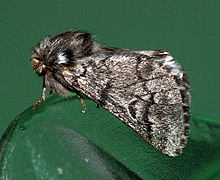Thaumetopoea
| Thaumetopoea | |
|---|---|

| |
| A Thaumetopoea species, pine processionary caterpillars | |
| Scientific classification | |
| Kingdom: | Animalia |
| Phylum: | Arthropoda |
| Class: | Insecta |
| Order: | Lepidoptera |
| Superfamily: | Noctuoidea |
| Family: | Notodontidae |
| Subfamily: | Thaumetopoeinae |
| Genus: | Thaumetopoea Hübner, 1820 |
| Synonyms | |
| |
Thaumetopoea is a genus of moths belonging to the family Notodontidae. It was first described by Jacob Hübner in 1820.
In their caterpillar form, they bear the vernacular name of processionary because these gregarious larvae move in a single file. In their imago (adult moth) form, members of this genus live a few days without feeding.
Some Thaumetopoea species, for example Thaumetopoea pityocampa, are lepidopteran defoliators experiencing an expansion range towards higher latitudes and altitudes due to the current climate warming.[1] Moreover, processionary caterpillars carry urticating setae, which cause health problems in humans.[2]
Systematics[]
The etymology of the genus name derives from the two ancient Ancient Greek words θαυματόεις (thaumatóeis), "marvelous", and ποιέω (poiéō), "to do", and literally means "showing beautiful things".[3][4] This explains why the name is sometimes spelled Thaumatopoea,[5] incorrectly from the taxonomic standpoint, but in accordance with its etymology.[citation needed]
The genus Thaumetopoea contains the following species:
- Thaumetopoea bonjeani (Powell, 1922) - cedar processionary
- Rambur, 1840
- Thaumetopoea pinivora (Treitschke, 1834) or Traumatocampa pinivora (Treitschke 1834) - eastern pine processionary
- Thaumetopoea pityocampa (Denis and Schiffermüller, 1775) or Traumatocampa pityocampa (Denis & Schiffermüller 1775) - pine processionary
- Thaumetopoea processionea (Linnaeus, 1758) - oak processionary
- Thaumetopoea solitaria (Freyer, 1838) - pistachio processionary or solitary
- Tams, 1924 or Traumatocampa wilkinsoni (Tams 1926)

References[]
- ^ Gschloessl, Bernhard; Vogel, Heiko; Burban, Christian; Heckel, David; Streiff, Réjane; Kerdelhué, Carole (2014). "Comparative analysis of two phenologically divergent populations of the pine processionary moth (Thaumetopoea pityocampa) by de novo transcriptome sequencing". Insect Biochemistry and Molecular Biology. 46: 31–42. doi:10.1016/j.ibmb.2014.01.005. PMID 24468684.
- ^ Battisti, Andrea; Larsson, Stig; Roques, Alain (31 January 2017). "Processionary Moths and Associated Urtication Risk: Global Change–Driven Effect s". Annual Review of Entomology. 62 (1): 323–342. doi:10.1146/annurev-ento-031616-034918. ISSN 0066-4170. PMID 27860523.
- ^ Bailly, Anatole (1 January 1981). Abrégé du dictionnaire grec français. Paris: Hachette. ISBN 2010035283. OCLC 461974285.
- ^ Bailly, Anatole. "Greek-French dictionary online". www.tabularium.be. Retrieved 30 October 2017.
- ^ Quicke, Donald L. J. (22 December 2014). The Braconid and Ichneumonid Parasitoid Wasps: Biology, Systematics, Evolution and Ecology. John Wiley & Sons. p. 515. ISBN 9781118907054.
- Thaumetopoeinae